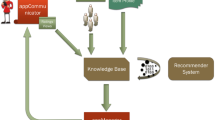Abstract
Visitors to cultural heritage sites are often overwhelmed by the information available in the space they are exploring. The challenge is to find items of relevance in the limited time available. Mobile computer systems can provide guidance and point to relevant information by identifying and recommending content that matches a user’s interests. In this paper we infer implicit ratings from observed viewing times, and outline a collaborative user modelling approach to predict a user’s interests and expected viewing times. We make predictions about viewing themes (item sets) taking into account the visitor’s time limit. Our model based on relative interests with imputed ratings yielded the best performance.
Access this chapter
Tax calculation will be finalised at checkout
Purchases are for personal use only
Preview
Unable to display preview. Download preview PDF.
Similar content being viewed by others
References
Petrelli, D., Not, E.: User-centred design of flexible hypermedia for a mobile guide: Reflections on the HyperAudio experience. User Modeling and User-Adapted Interaction 15(3-4), 303–338 (2005)
Oppermann, R., Specht, M.: A context-sensitive nomadic information system as an exhibition guide. In: Thomas, P., Gellersen, H.-W. (eds.) HUC 2000. LNCS, vol. 1927, pp. 127–142. Springer, Heidelberg (2000)
Hatala, M., Wakkary, R.: Ontology-based user modeling in an augmented audio reality system for museums. User Modeling and User-Adapted Interaction 15(3-4), 339–380 (2005)
Zukerman, I., Albrecht, D.W.: Predictive statistical models for user modeling. User Modeling and User-Adapted Interaction 11(1-2), 5–18 (2001)
Albrecht, D.W., Zukerman, I.: Introduction to the special issue on statistical and probabilistic methods for user modeling. User Modeling and User-Adapted Interaction 17(1-2), 1–4 (2007)
Burke, R.: Hybrid recommender systems: Survey and experiments. User Modeling and User-Adapted Interaction 12(4), 331–370 (2002)
Berlyne, D.E.: Conflict, Arousal, and Curiosity. McGraw-Hill, New York (1960)
Heinrich, P.: “Free looking time”: Eine Methode zur Präferenzbestimmung. Psychologie und Praxis 14(2), 79–93 (1970)
Fink, J., Kobsa, J.: User modeling for personalized city tours. Artificial Intelligence Review 18(1), 33–74 (2002)
Shardanand, U., Maes, P.: Social information filtering: Algorithms for automating “word of mouth”. In: CHI 1995. Proceedings of the 1995 SIGCHI Conference on Human Factors in Computing Systems, pp. 210–217 (1995)
Resnick, P., Iacovou, N., Suchak, M., Bergstrom, P., Riedl, J.: GroupLens: An open architecture for collaborative filtering of netnews. In: CSCW 1994. Proceedings of the 1994 ACM Conference on Computer Supported Cooperative Work, pp. 175–186 (1994)
Véron, E., Levasseur, M.: Ethnographie de l’exposition. Bibliothèque Publique d’Information, Centre Georges Pompidou, Paris (1983)
Sparacino, F.: The Museum Wearable – Real-time sensor-driven understanding of visitors’ interests for personalized visually-augmented museum experiences. In: MW 2002. Proceedings of the 11th International Conference on Museums and the Web (2002)
Zancanaro, M., Kuflik, T., Boger, Z., Goren-Bar, D., Goldwasser, D.: Analyzing museum visitors’ behavior patterns. In: UM 2007. Proceedings of the 11th International Conference on User Modeling (2007)
Herlocker, J.L., Konstan, J.A., Terveen, L.G., Riedl, J.T.: Evaluating collaborative filtering recommender systems. ACM Transactions on Information Systems 22(1), 5–53 (2004)
Author information
Authors and Affiliations
Editor information
Rights and permissions
Copyright information
© 2007 Springer-Verlag Berlin Heidelberg
About this paper
Cite this paper
Bohnert, F., Zukerman, I. (2007). Using Viewing Time for Theme Prediction in Cultural Heritage Spaces. In: Orgun, M.A., Thornton, J. (eds) AI 2007: Advances in Artificial Intelligence. AI 2007. Lecture Notes in Computer Science(), vol 4830. Springer, Berlin, Heidelberg. https://doi.org/10.1007/978-3-540-76928-6_38
Download citation
DOI: https://doi.org/10.1007/978-3-540-76928-6_38
Publisher Name: Springer, Berlin, Heidelberg
Print ISBN: 978-3-540-76926-2
Online ISBN: 978-3-540-76928-6
eBook Packages: Computer ScienceComputer Science (R0)




